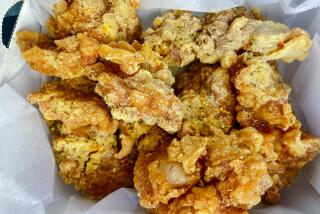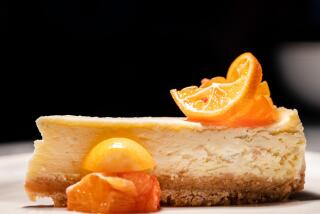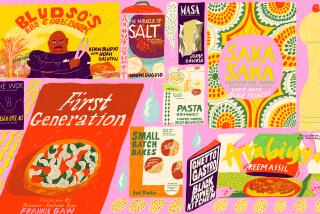Made for each other
A nice warm bistro is usually the best antidote to January, with flowers and Burgundy and black-and-white photos of Paris guaranteed to recalibrate the bleakest mood. But the one I wandered into on a particularly nasty night turned out to have an even more effective cure: cheese and potatoes.
They were together in a first course called salade petatou, chunks of crumbly Yukon Gold potatoes in vinaigrette baked under a crown of fluffy goat cheese. Ordering it felt like a vote against all those seasonally insensitive salads with tomatoes and asparagus that are everywhere these days. And eating it was like being warmed through, almost from the soul out.
Cheese and potatoes are just the ultimate winter ingredients. As irresistible as they each are alone and in any other season, as a team they have the power to cheer you up or calm you down. Both are soothing and easy to eat, not to mention rib-sticking in the best wintry way. The fact that almost any cheese is even better melted only adds to the appeal.
All things starchy go with cheese, whether bread or tortillas, rice or pasta, but potatoes meld with it like no other carbohydrates. They’re also sturdy enough to absorb all the rich creaminess you can throw at them. No place knows that better than Old Europe, which got the potato rather late in life from South America but has produced many classic cheese pairings.
Probably the most famous are gratins, the prototype for American scalloped potatoes, which can be almost obscenely rich and hearty. But potatoes also get mixed up with cheese in pierogi, the Polish answer to ravioli and the ultimate example of the whole adding up to more than the parts, and in airy but oozy gnocchi, with Gorgonzola adding its blue bite.
My wake-up salad made me think about how far both potatoes and cheese have come in this country since the first disk of warm chevre was laid on greens in California decades ago. Even the most unambitious supermarket now carries dozens of choices of cheeses beyond American that melt unctuously well over potatoes, whether Swiss Gruyere, French Camembert or even Mexican cheeses such as queso fresco.
*
Mix and match
At the same time, the vegetable aisle has sprouted “new” varieties of potatoes. Nothing goes better with cheese than yellow-fleshed Yukon Golds, which not only taste almost like a dairy product but cook up to a nearly creamy consistency -- unless it’s heirloom Carolas, with their buttery-tasting flesh, or tiny La Rattes, which roast up even crunchier with a coating of Parmigiano-Reggiano or Cheddar.
I’m such a sucker for cheese and potatoes that I have been known to order -- and finish -- cheese fries as an entree. (Canadians would add gravy and call it poutine, and George W. Bush would call that an endorsement.) But in polite company I would always stick to more refined combinations. The most traditional are those gratins, with sliced potatoes layered with grated cheese, moistened with cream and baked until they’re soft and creamy inside and crusty on top.
Gruyere is the quintessential gratin cheese, especially in the gratin dauphinois dictated by Larousse, although Cheddar will work, or a buttery Brie variation, or even almost any blue cheese. My excessive side, though, likes a gratin modeled on pasta sauce with multiple cheeses: aged Gorgonzola for tang, Italian fontina for almost nutty-tasting creaminess and Parmigiano-Reggiano for roundness and perfect crustiness.
No matter what the cheese, the best potatoes for a gratin are Yukon Golds or russets (aka Idahos). Waxy potatoes are specified in plenty of traditional French recipes, but their texture seems to repel the cheese rather than soak it in the way a fluffier, more crumbly type does.
Aligot is less well known in this country than gratins but is one of the world’s greatest match-ups of cheese and potatoes. Essentially garlicky mashed potatoes with cheese melted in, it originated in the Auvergne region of France, known for its ski slopes and hearty appetites. It seems like a peasant dish, but Michel Bras is almost as well known for his variation on it at his Michelin three-star restaurant as he is for his field-foraged herbs.
I have only had aligot in American restaurants and seen it in Larousse, where the photo shows it pulling out like a sheet of rubber that could almost be cut with scissors. And I soon learned why it is so rare here.
I found one recipe in Roy Andries de Groot’s classic “Auberge of the Flowering Hearth” and crossed it with another from Steven Jenkins, whose 1986 “Cheese Primer” is still without rival. His formula was modeled on one from a Paris restaurant, Ambassade d’Auvergne, using bacon fat, which is traditional, but also creme fraiche, which is not. Otherwise, he and De Groot were on the same ingredients page: russet potatoes, garlic, butter and cheese. Lots of cheese.
*
Very creamy, very rich
The right stuff is fresh curds from Cantal or Salers, which are not available here. Jenkins suggested crescenza or stracchino, both almost gooey Italian cheeses, to produce what he described as the perfect consistency: “homogenous, unctuous and runny without dripping.” De Groot said the finished dish should be like “mixed spaghetti and noodles.” I wound up with very, very creamy, very rich, very bacony mashed potatoes I wouldn’t kick out of my kitchen but that might disappoint anyone with memories of cheese dripping from a spatula like sheets of wet paint.
Another cheese-potato marriage from the mountains of Europe is much easier: raclette, a specialty in both the French and Swiss Alps. And if cheese is milk’s great leap toward immortality, as someone once put it, raclette is cheese and potatoes’ pole vault.
A half wheel of cheese is melted, traditionally alongside a fireplace, and scraped off as it turns liquid to be served with boiled small potatoes, cornichons and pickled onions.
I once had raclette at a Swiss tourism promotional party, and diners ate all the components in alternating mouthfuls or just dredged the potatoes through the cheese. Not only is the contrast between vegetable and dairy immensely satisfying, but you also understand why the potatoes are there: for easy eating now and digestion later.
Not surprisingly, the perfect cheese for raclette is actually labeled Raclette. It comes in a round measuring 13 to 17 inches across but is most often sold in wedges meant for melting for small groups. You can rent or buy a machine to hold and scrape the cheese as it melts, or you can just follow Jenkins’ primer: Melt 4-ounce slices on individual plates in a 425-degree oven until the cheese is runny, like pizza without the crust or fondue without the pot. Bread is almost as good as potatoes for dunking in it.
*
The simple approach
Jenkins has the best description for the flavor, “beefy,” and the cheese needs nothing more once it melts. A glass of Fendant, a Swiss white wine, is traditional with raclette, but he recommends a Beaujolais such as Fleurie or Saint-Amour.
The French have other direct ways to serve cheese with potatoes, though. Vacherin, when it is really, really ripe, can be dip and bowl for sliced potatoes: It gets so runny it is almost the consistency of cream when you slice off the top of a whole round of cheese and dunk the potato slices.
But the easiest way to combine potatoes and cheese beyond that may be the bistro salad I came across. Petatou loosely translates as “timbale,” which means it was just a layer of warm, well-dressed, crumbly potato chunks packed into a ring and topped with soft, creamy goat cheese. Extra vinaigrette and mounds of olives were arranged around it on the plate, to make each bite a little sharper and richer.
Salade petatou is also sometimes made with a layer of sauteed shiitakes or toasted hazelnuts between the potatoes and cheese. Either of those can also be used as garnishes instead of olives. But the best presentation is just cheese and potatoes, warmed through.
You’ll almost wish for stormy weather. Almost.
**
Three-cheese potato gratin
Total time: About 2 hours
Servings: 6
1 tablespoon butter
1 clove garlic
1/4 cup crumbled Gorgonzola
1/2 cup grated fontina
3/4 cup freshly grated Parmigiano-Reggiano, divided
2 pounds Yukon Gold or russet potatoes, divided
Salt and freshly ground black pepper to taste
1/4 teaspoon freshly grated nutmeg
1 cup heavy cream
1. Heat the oven to 325 degrees. Butter an 8-by-12-inch square or oval gratin pan. Cut the garlic in half and rub the cut side all over the interior of the pan. Set aside.
2. Combine the Gorgonzola with the fontina and one-fourth cup Parmigiano-Reggiano. Set aside.
3. Peel the potatoes and place them in cold water. Remove 2 potatoes and pat dry. Thinly slice them and overlap the slices in the gratin dish. Season well with salt and pepper to taste. Distribute the combined cheeses evenly over the potatoes. Thinly slice the remaining potatoes and layer them over the cheese. Season with salt, pepper and nutmeg.
4. Pour the cream evenly over the potatoes. Distribute the remaining Parmigiano-Reggiano evenly over the cream.
5. Bake 1 hour, 15 minutes, until the cream is bubbly, the top is well browned and the potatoes are tender. Let stand for 5 minutes before cutting into squares to serve.
Each serving: 358 calories; 11 grams protein; 26 grams carbohydrates; 2 grams fiber; 24 grams fat; 15 grams saturated fat; 82 mg. cholesterol; 358 mg. sodium.
**
Salade petatou (Warm goat cheese and potato salad)
Total time: About 1 hour
Servings: 4
Note: You can vary the flavor by substituting a combination of hazelnut and peanut oils for the olive oil and toasted, chopped hazelnuts for the olives. You will need baking rings or aluminum ring molds, which are available at Surfas in Culver City, Cook N Stuff in Torrance and Sur La Table stores.
2 medium Yukon Gold
potatoes, scrubbed
Sea salt to taste
3 tablespoons sherry
vinegar
1 small shallot, minced
2 teaspoons minced fresh thyme
6 tablespoons extra-virgin olive oil
Freshly ground black
pepper to taste
6 ounces soft goat cheese
1/2 cup heavy cream
16 to 20 large green and black olives in brine, pitted and quartered lengthwise
1. Heat the oven to 325 degrees. Oil 4 (4-inch) baking rings and arrange on an oiled baking sheet.
2. Place the potatoes in a saucepan and add water to cover by 2 inches. Add about 1 teaspoon salt. Bring to a boil, reduce the heat and simmer until soft but not falling apart.
3. While the potatoes cook, combine the vinegar, shallot, thyme and salt to taste in small bowl. Whisk until smooth, then whisk in the olive oil. Season with black pepper to taste. Set aside.
4. Drain the potatoes well and let them stand until cool enough to handle, then peel and transfer to a mixing bowl. Cut them into rough chunks. Add half the reserved vinaigrette. Mix with a rubber spatula until well coated. Taste and add more salt if needed and pepper to taste. Divide the mixture among prepared rings, packing to solidify slightly.
5. In a second bowl, combine the goat cheese and cream and blend until smooth. Season lavishly with black pepper. Divide among the prepared rings, smoothing the top on each. Bake 15 to 17 minutes, until the cheese is warmed through.
6. Transfer the rings to serving plates with a spatula and remove the rings. Arrange olives alongside or around each salad and drizzle vinaigrette around plate. Serve at once.
Each serving: 516 calories; 11 grams protein; 25 grams carbohydrates; 3 grams fiber; 42 grams fat; 16 grams saturated fat; 60 mg. cholesterol; 348 mg. sodium.
**
Cheese-crusted potatoes
Total time: 30 minutes
Servings: 4
Note: You can vary these by adding some dried herbs (such as thyme, basil or herbes de Provence) with the cheese. Russian Banana fingerlings, available at Whole Foods markets and Santa Monica Farmers Market, have a similar flavor to the La Ratte potatoes.
16 large (about 3-inch) La Ratte or other fingerling
potatoes
1 tablespoon extra-virgin
olive oil
1/2 teaspoon coarse sea salt or kosher salt
1/4 teaspoon cayenne
1/2 cup finely grated Cheddar, Parmigiano-Reggiano or manchego
1/4 teaspoon dried herbs (optional)
1. Heat the oven to 400 degrees.
2. Scrub the potatoes and dry thoroughly. Cut each in half lengthwise and place in a bowl. Add the oil, salt and cayenne and toss using your hands or a rubber spatula until the oil coats the potatoes well on all sides and the seasonings are evenly distributed.
3. Arrange the potatoes cut side down on a heavy baking sheet lined with foil. Bake 15 to 20 minutes, or until the flesh is tender (baking time will depend on the size of potatoes).
4. Remove the potatoes from the oven and carefully turn each half over. Sprinkle the cheese heavily over each half then, if using them, sprinkle on the dried herbs. Return to the oven and bake 5 minutes, or until the cheese is melted.
Each serving: 334 calories; 9 grams protein; 57 grams carbohydrates; 5 grams fiber; 8 grams fat; 3 grams saturated fat; 15 mg. cholesterol; 394 mg. sodium.


